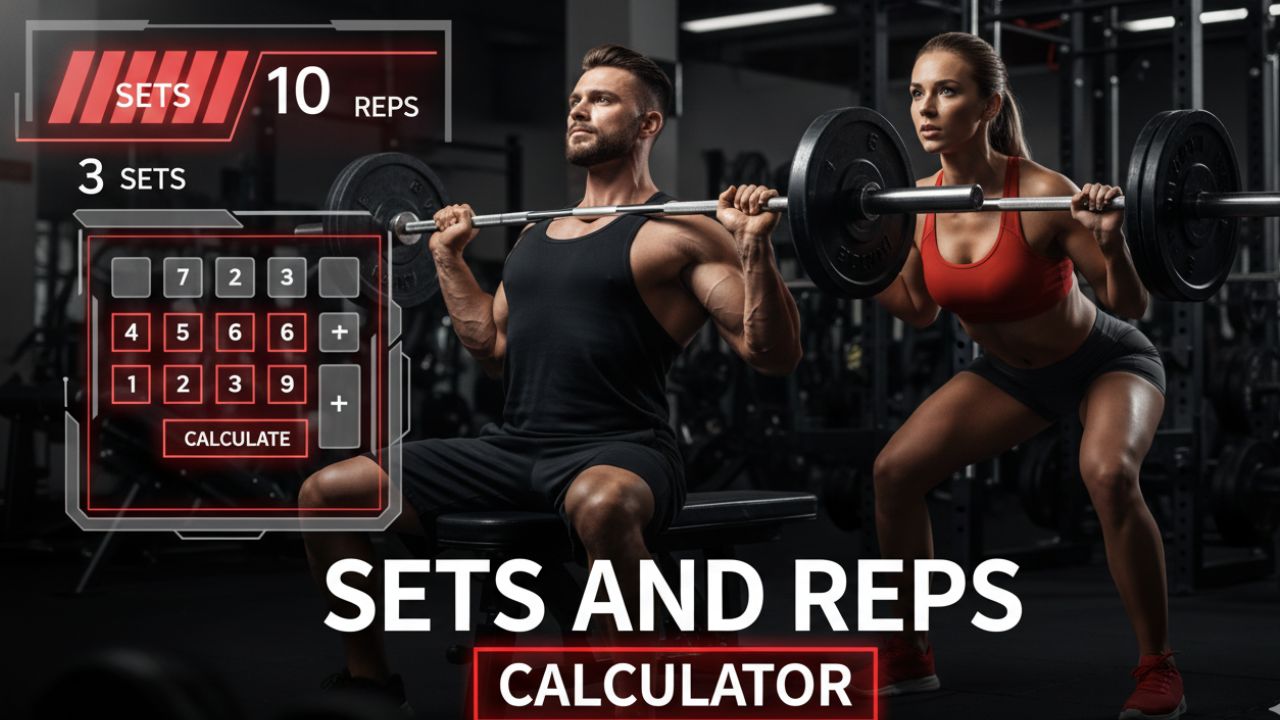Sets and Reps Calculator
Find your optimal training protocol and calculate your one-rep max
💡 Complement your training with our Workout Intensity Calculator for comprehensive training guidance
Intermediate: Use 3-4 sets per exercise, gradually increasing weight as you get stronger.
Advanced: Incorporate 4-6 sets per exercise, including drop sets or supersets for added challenge.
Rest Periods: 2-3 minutes for strength, 60-90 seconds for hypertrophy, 30-60 seconds for endurance.

What Are Sets and Reps?
In strength training, a “rep” (repetition) is one complete movement of an exercise, like one squat or one push-up. A “set” is a group of reps performed one after another without stopping. For example, 3 sets of 10 reps means you do 10 reps, rest, do 10 more reps, rest, and then do 10 final reps.
The right combination of sets and reps depends on your training goals. Different rep ranges stress your muscles in different ways, leading to different adaptations in strength, size, or endurance. For a complete analysis including RPE and heart rate methods, check our Workout Intensity Calculator.
Rep Ranges for Different Goals
Research shows that different rep ranges produce different training adaptations:
How Many Sets Should You Do?
The number of sets depends on your training experience and goals:
- Beginners: 2-3 sets per exercise to focus on learning proper form
- Intermediate: 3-4 sets per exercise for balanced muscle development
- Advanced: 4-6 sets per exercise, often including advanced techniques like drop sets
Remember, quality matters more than quantity. It’s better to do fewer sets with perfect form than many sets with poor technique.
Understanding One-Rep Max (1RM)
Your one-rep max (1RM) is the maximum weight you can lift for a single repetition with proper form. It’s a key benchmark for measuring strength progress and programming training loads. Our calculator uses an advanced RPE-based approach that’s more accurate than traditional formulas.
If you lift 200 lbs for 8 reps at RPE 9 (very hard):
Base 1RM = 200 × (36 ÷ (37 – 8)) = 200 × 1.241 = 248 lbs
RPE Adjustment = 248 × 0.90 = 223 lbs
This RPE-adjusted estimate is more accurate because it accounts for the fact that RPE 9 means you had 1 rep left in the tank.
RPE and Reps in Reserve
Rate of Perceived Exertion (RPE) measures how hard a set feels on a scale of 1-10. Modern RPE is based on “Reps in Reserve” (RIR) – how many more reps you could have done before reaching failure.
How to Use This Calculator
For Training Guidance:
- Choose your primary training goal (strength, hypertrophy, endurance)
- Follow the recommended rep ranges and set numbers
- Adjust based on your experience level and recovery ability
For 1RM Calculation:
- Select your exercise for more accurate calculations
- Enter the weight you lifted and number of reps completed
- Rate how hard the set felt (RPE) for maximum accuracy
- Get your estimated 1RM and personalized training recommendations
- Track your progress over time with the built-in history feature
💡 For advanced intensity analysis including heart rate zones and detailed RPE breakdowns, visit our Workout Intensity Calculator.
Advanced Training Techniques
Once you’re comfortable with basic sets and reps, these advanced techniques can help you break through plateaus and accelerate progress:
⚕️ Important Safety Notes
This calculator provides estimates based on scientific formulas and research. Individual results may vary based on factors like training experience, genetics, sleep, nutrition, and recovery. Always prioritize proper form and start conservatively. If you have any health conditions or concerns, consult with a healthcare provider or certified fitness professional before beginning a new training program.
References
- Schoenfeld BJ, Grgic J, Van Every DW, Plotkin DL. Loading Recommendations for Muscle Strength, Hypertrophy, and Local Endurance: A Re-Examination of the Repetition Continuum. Sports (Basel). 2021 Feb 22;9(2):32. doi: 10.3390/sports9020032. PMID: 33671664; PMCID: PMC7927075.
- Adda, Ghoual. (2019). The effect of repetition ranges on maximal strength and hypertrophy. International Journal of Physical Education, Fitness and Sports. 8. 149-157. 10.26524/ijpefs19415.
- Morton, R. W., Colenso-Semple, L., & Phillips, S. M. (2019). Training for strength and hypertrophy: An evidence-based approach. Current Opinion in Physiology, 10, 90-95. https://doi.org/10.1016/j.cophys.2019.04.006
